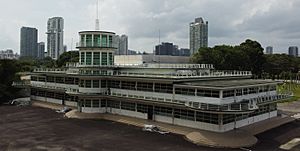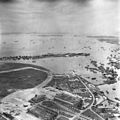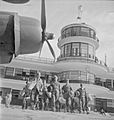Kallang Airport facts for kids
Quick facts for kids
Singapore International Airport
Lapangan terbang Antarabangsa Singapura
加冷机场
காலாங் வான்முகம்
|
|||||||||||
|---|---|---|---|---|---|---|---|---|---|---|---|

The control tower of Kallang Airport
|
|||||||||||
| Summary | |||||||||||
| Airport type | Defunct | ||||||||||
| Serves | Singapore | ||||||||||
| Location | 9 Kallang Airport Way, Singapore 397750 | ||||||||||
| Opened | 12 June 1937 | ||||||||||
| Closed | 1955 | ||||||||||
| Coordinates | 01°18′26.68″N 103°52′24.16″E / 1.3074111°N 103.8733778°E | ||||||||||
| Runway | |||||||||||
|
|||||||||||
Kallang Airport was Singapore's very first international airport built just for civilian flights. It officially opened on June 12, 1937. This amazing airport stopped operating in 1955. Its flights then moved to Paya Lebar.
Kallang Airport was located on the eastern side of the Kallang Basin. It covered parts of what are now the Kallang and Geylang areas. The main airport building and other important parts are still there in Kallang today.
This airport was special because it had a place for seaplanes to land on the water. People at the time called it "the finest airport in the British Empire". Even the famous pilot Amelia Earhart called it "an aviation miracle of the East".
Building the airport started in 1931. Workers had to reclaim land from 300 acres of swamp. This project caused a large Malay community to move to the Jalan Eunos area. The first planes, three Hawker Osprey aircraft, landed there in 1935. This was two years before the official opening.
During World War II, Kallang Airport was Singapore's only working airfield. It helped Allied forces fight against the Japanese. While the Japanese occupied Singapore, the airport's grass landing area was made into a concrete runway. It was also made longer, reaching 5,500 feet.
By 1950, Kallang Airport was too busy for all the planes. So, plans were made to build a new airport at Paya Lebar. Kallang Airport finally closed its doors in 1955.
After it closed, different groups used the Kallang Airport area. The People's Association used the main building as its headquarters from 1960 to 2009. Many parts of the airport were taken down after it closed. But some important buildings still stand. These include the main terminal, office blocks, plane hangars, and the control tower. Singapore's Urban Redevelopment Authority protected these buildings in 2008.
Other parts of the airport land were redeveloped. The area around the old runway became Kallang Park. Later, the old National Stadium was built there. Today, the Singapore Sports Hub stands on this site. It includes the new National Stadium and Singapore Indoor Stadium. The eastern part of the airport became a modern housing area called "Old Kallang Airport Estate".
Kallang Airport was also a location for the 2011 Singapore Biennale art festival. There are plans to turn the Kallang Airport area into a busy commercial center. This will happen along with the nearby Kallang riverside.
Today, some roads remind us of the airport. These include Old Airport Road, Kallang Airport Drive, and Kallang Airport Way. Old Terminal Lane points to the old terminal building. Dakota Crescent, Dakota Close, and Dakota MRT station are named after the Douglas DC-3 "Dakota" planes. These planes often landed at Kallang Airport. They also remember a plane accident in 1946.
Contents
A Look Back: Kallang Airport's History
How Kallang Airport Got Its Name
Kallang Airport is named after the nearby Kallang Basin. The basin itself was named after a group of sea-travelers who lived there in the 1800s.
Commercial flights in Singapore began on February 11, 1930. A Dutch airline called KLM flew from Amsterdam to Batavia (now Jakarta). The plane landed at Seletar. It carried passengers, fruit, flowers, and mail. KLM later started regular flights on this route.
In July 1933, Imperial Airways, a big British airline, started flights between London and Darwin. This route included stops in Singapore. Later, this service was extended to Brisbane. It was run together with Qantas.
More and more planes were flying, and the existing Seletar Airbase became too crowded. So, a new airport was needed. On August 31, 1931, Sir Cecil Clementi, who was in charge of the Straits Settlements, announced that Kallang Basin would be the new airport site. It was chosen because it was close to the city. Also, its location next to Kallang Basin was perfect for seaplanes.
Building the Airport
Work to reclaim land began in 1932. About 103 hectares of swamp in Kallang Basin were filled in. Seven million cubic meters of earth were used for this. By 1936, all the land was ready. It formed a round landing area, 915 meters wide.
On June 12, 1937, the Kallang Aerodrome officially opened. Sir Shenton Thomas opened it. He had taken over from Sir Cecil in 1934. At that time, people called it "the finest airport in the British Empire". It had very modern features. The round shape allowed planes to land from any direction. Seaplanes could also use the same terminal building as regular planes.
Kallang Airport During World War II
When the Japanese attacked Malaya and Singapore on December 8, 1941, Kallang was the main airfield for fighter planes. By January 1942, it was the only working fighter airfield in Singapore. Other airfields were too close to Japanese guns in Johor Bahru.
Planes like the Brewster Buffalo and Hawker Hurricanes flew from Kallang. They defended Singapore from Japanese air attacks. But many planes and pilots were lost. By late January 1942, the airfield was badly damaged. Only a few planes could still fly. The last fighters left in early February. They escaped to continue fighting just before Singapore was taken by the Japanese.
After the War: Changes and Growth
Plane traffic slowed down during the war years. During this time, the round landing area was changed into a single runway for warplanes. After the war, airlines like the British Overseas Airways Corporation (BOAC) and Qantas started their regular flights again. A local airline, Malayan Airways (MAL), began flights on May 1, 1947.
In the early 1950s, planes became bigger and needed longer runways. So, the runway was made longer. It stretched beyond Mountbatten Road into what is now Old Airport Road. The new runway was 5,496 feet long and 165 feet wide. This meant that traffic lights had to be put in place. They would stop cars every time a plane took off or landed.
Photo gallery
-
Abandoned Japanese Kawasaki Ki-45 fighters during the liberation of Singapore
Important Events and Accidents
- On November 7, 1941, a Royal Air Force Tiger Moth plane was hit by another plane landing at the airport.
- On June 29, 1946, a Dakota aircraft from the Royal Air Force Police crashed during a storm. All 20 people on board were lost.
- On March 13, 1954, a BOAC Lockheed Constellation plane had an accident while trying to land. This happened on its way to London from Sydney. Sadly, 32 people were involved in this event, including eight crew members. An investigation found that the pilot was very tired. There were also problems with how quickly fire and rescue services responded. This was the most serious flight accident in Singapore's history.
Kallang Airport's Lasting Legacy
Kallang Airport has left many reminders of its past. The old runway near Mountbatten Road is now called Old Airport Road. The public housing blocks there are named the Old Kallang Airport Estate. The Dakota MRT station serves this area. It gets its name from the Dakota DC-3 planes that used to land at Kallang Airport.
Two new roads near Kallang MRT station are named "Kallang Airport Drive" and "Kallang Airport Way". Also, Old Terminal Lane connects Geylang Road with Kallang Airport Way. This name refers to the airport's old terminal building, which is still standing.
The area where seaplanes used to land is now home to the Oasis Building. The main terminal building was used by the People's Association until April 9, 2009. They then moved to a new headquarters. The People's Association building hosted many activities for the community.
The Urban Redevelopment Authority (URA) of Singapore officially protected Kallang Airport for conservation on December 5, 2008.
Airport Architecture: A Modern Design
The original Terminal Building is a famous example of modern architecture. It features Art Deco-style railings and columns. These were designed by Frank Dorrington Ward. The building shows a simple, clean design with few decorations. It uses clear materials, making it look lighter. Also, different parts of the building clearly show their different uses.
In the middle, there is a round glass control tower. On each side, there are two blocks that were part of the terminal. They have an open-air viewing deck on the top floor. The People's Association kept the concrete structure and glass walls. They also fixed the outside of the building. They closed some gates and rebuilt a window on the second floor. This helped reshape the inside for office use.
See also
- Battle of Singapore
- Far East Air Force (Royal Air Force)
- Former Overseas RAF bases









